What is a Standard Operating Procedure (SOP)?
This post may include affiliate links, meaning we might earn a commission. For more details, check out our terms.
Chances are you’ve heard the term “Standard Operating Procedure” or perhaps the acronym “SOP.” You know that this is a commonly discussed topic in the business world, but if you’re being honest, you don’t know what the heck a Standard Operating Procedure is!
Not to worry! In this article, I’ll break down everything you need to know about writing standard procedures that make work easier.
SOPs provide detailed instructions to guide the reader toward a specific outcome or result.
Sound a bit confusing? One shortcut for remembering the meaning of SOP is to think of it just like a recipe!
An SOP is a recipe for how to execute a specific business process.
Picture a chef making his world-famous alfredo pasta. Around the kitchen, the chef is surrounded by ingredients: sauce, pasta, seasoning, and equipment. Using a recipe (and some skill), the chef follows a series of steps to ensure the alfredo pasta is always delicious. 🧑🍳
The chef’s recipe is a Standard Operating Procedure!
As is true with any great Standard Operating Procedure – you need the ingredients (or inputs and outputs), instructions, and steps so the recipe can be followed easily.
Looking for Standard Operating Procedure Examples to get inspired by? We’ve curated 109 SOP examples that every team can consider when turning their operations into a well-oiled machine. Unlock your free PDF download at https://processdriven.co/sops
Not sure if you need SOPs? Here are 5 benefits.
Benefit #1: You can ensure consistent results.
If you’re not using SOPs with your team, you likely lack stable and predictable outcomes. Why would you have consistent results if your team is doing the same process differently each time? Exactly.
If your team follows all the steps outlined in an SOP, you ensure the process is done correctly. Without consistency, your business will never scale.
Benefit #2: You can train new team members more efficiently.
Training new team members will be a breeze if you have solid SOPs in your business. Instead of typing everything out for them or verbally stating everything in a meeting, you just send them links to any relevant SOPs!
Besides detailed training, you also ensure that your new hires receive the most up-to-date information, which gives you peace of mind.
Benefit #3: You don’t have to remember everything.
Humans are prone to errors – especially when relying on our memory! By implementing SOPs, you and your team now have handy guides you can use at any moment.
The alternative is important work slipping through the cracks, overdue tasks, and angry team members. This can be avoided by simply documenting your processes!
Benefit #4: You build the value of your business as an asset.
The valuation of your company is determined, in part, by the amount of value-generation potential your operation can deliver sustainably — regardless of which humans are inside that organization.
When seeking financing or exploring M&A, the strength of your operating procedures may be considered a key indicator of the operation’s sustainability.
Imagine two scenarios:
-
- Company A has SOPs that provide detailed instructions for how any human could operate the organization and sustainably generate profit.
-
- Company B relies on a few superhero employees who “just know” how to operate things…but no one else could replicate what they’ve done.
Which would you consider the more valuable asset? Exactly!
Procedures can increase your company’s value by creating a playbook of instructions that make success sustainable and sellable.
Benefit #5: You can take a vacation.
Without a process, it can be easy for leadership to feel like they must constantly work to ensure everything is operating smoothly.
By ensuring your team writes SOPs, you can take time — once! — to define exactly what success looks like in any business process. The SOP removes the guesswork (and the worry!). With SOPs in place, leaders can take a step back (or even leave for vacation!) without worrying about day-to-day work running off the rails.
SOPs ensure processes in your business are being executed efficiently and predictably.
Common Myths & Misconceptions About SOPs (Debunked!)
Like most things on the Internet, there’s a lot of misinformation about SOPs.
At ProcessDriven, we believe documenting your processes – which includes creating SOPs – is crucial to the success of your business.
If we believe the misconceptions around SOPs, we’re naturally inclined to either continue stalling the process or shy away from implementing them.
Some common misconceptions about SOPs you might’ve heard of include:
| Myth | Reality |
| Belief #1: I need to spend hours perfecting my SOPs. | You shouldn’t spend more than 15 minutes creating an SOP from start to finish. |
| Belief #2: I need to create an 8-10 page SOP with a bunch of details. | Your SOP should be less than one page. |
| Belief #3: I don’t want to waste my time creating SOPs since my team will never use them. | Your team absolutely needs to be using your SOPs, so your business processes are solid and to ensure things are being done the way you want. |
| Belief #4: I don’t need SOPs because the training I provided my team is enough. | Things are constantly changing in every business – so will your SOPs. Your team needs to get in the habit of using SOPs every time they do a process to ensure they are doing it the right way. |
| Belief #5: I don’t think my team will think my SOPs are helpful to them in their day-to-day. | Your SOPs should be solid and straightforward, so your team actually enjoys reading them. Your SOPs shouldn’t put your team to sleep. |
| Belief #6: It’s impossible to document my processes and turn them into SOPs because they are simply too complicated to capture. | Every process can be documented and turned into an SOP, no matter the level of difficulty of the actual process. |
What are some common Standard Operating Procedure (SOP) formats?
Now that you understand what SOPs are, you might wonder, “Wait, what does an SOP actually look like?”
Just like recipes, there’s no one-size-fits-all format for Standard Operating Procedures! The three common forms of SOP are Conversational, Recording, and Writing. I’ll define each below.
Conversational SOPs (Non-Recorded)
One popular choice is conversation-based SOPs. This method is quick and easy.
To create a conversation-based SOP, you simply have a casual conversation with a team member. Then, that team member would need to remember everything you said…forever.
The problem with this method is that you’d have to rely on someone else’s memory.
Because human memory is imperfect, a conversation-based SOP is a convenient but shortlived format for SOPs.
In most situations, we do not recommend implementing this SOP method with your team without supplementing it with an additional SOP format that we’ll cover below.
Recording SOPs as videos
One of the most popular SOP formats is video-based SOPs using software such as ClickUp’s Clips or Loom video recordings.
You can film yourself doing something and then send it to a team member so they can repeat the same steps. You can record your screen as you work through something and post it so future employees (or future you) know what to do without struggling.
Video-based SOPs are highly convenient for the creator and avoid relying heavily on human memory.
This video-based SOP format makes the most sense, right? Not so fast!
Despite the convenience of recording a video, updating videos are generally highly inconvenient.
Imagine if every time you made a small change to an SOP, you had to re-record a video, edit it, and post it where your team could see. You wouldn’t have time to get anything else done!
That’s why video-based SOPs have a high likelihood of becoming out-of-date. There’s little friction to creating them, but there’s a lot of friction when it comes to editing or even consuming video-based content, just to name a few reasons.
For those reasons, video SOPs are rarely the strongest choice for a process-driven organization.
Writing SOPs in Text or Documents
The third SOP format we’ll discuss (and our personal favorite) is text-based SOPs.
While text-based SOPs can require more time to create upfront, they’re incredibly convenient for the SOP readers and editors who may need to adjust the SOP down the line.
Many leaders and business owners loathe the idea of text-based SOPs because they think it will be too labor-intensive. Often, this fear is rooted in the (false) belief that SOPs must be outdated 10-page documents filled with footnotes and annotations that no one ever reads.
In reality, we can avoid this by following one simple practice:
Do not write long, boring SOPs.
Instead, ProcessDriven believes that the most valuable SOPs are short, skim-friendly, and extremely easy to update.
Rather than writing an SOP in one long sitting, we suggest an iterative approach and limiting any SOP to no more than eight steps or one page, excluding images.
As a rule of thumb, you shouldn’t spend more than 15 minutes creating an SOP.
You might think, “How the heck am I supposed to write an SOP in 15 minutes or less?”
The solution? Use a template!
You create the template once, save it, and then fill in the blanks for each process. Voilà! You’ve got yourself an SOP. We’ll dig into this in the next section…
Looking for Standard Operating Procedure Examples to get inspired by? We’ve curated 109 SOP examples that every team can consider when turning their operations into a well-oiled machine. Unlock your free PDF download at https://processdriven.co/sops
What is the Structure of a Standard Operating Procedure (SOP)?
Now that we’re all clear on why teams need robust SOPs, let’s discuss how to start creating those SOPs.
Every SOP template should have three essential components: Start, Stop, and Steps.
Step 1. Pick the Start of the SOP
First, you need to ask yourself: Where does this process begin?
Do you need to access a specific tool to get started? The first step in this process will be your “starting point.”
To make it easy to document this Start, we’ll create an “Input” section at the top of any given SOP that describes the ingredients or context required in the SOP.
For example, the SOP for “How to Send New Team Member Onboarding Emails” might start with:
Input:
-
- There’s a new hire who needs to receive the “New Team Member Onboarding” email series.
-
- You have editing access to our Email Marketing Software.
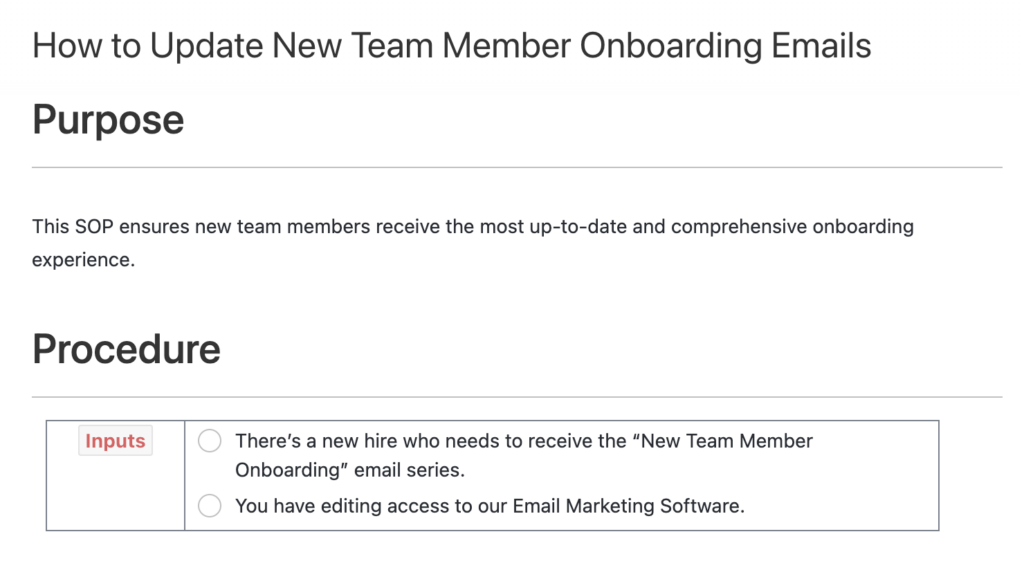
Step 2. Define the Stop of the SOP
Second, you need to ask yourself: Where does this process end?
What signals to me that I’m 100% done with this process? What’s the last step before I say, “I am done with this task and moving on to something else?”
We’ll call this Stop the “Output” and write it at the bottom of our SOP.
For example, the SOP for “How to Update New Team Member Onboarding Emails” might end with:
Output:
-
- The new hire(s) have been added to the “New Team Member Onboarding” email series.
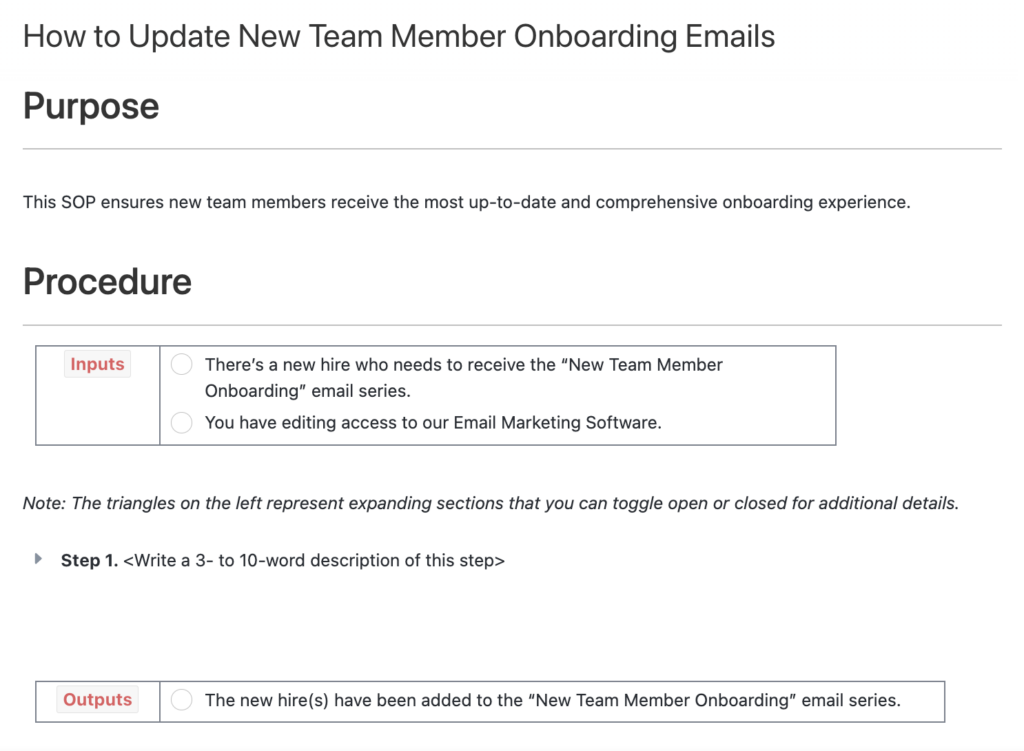
Having the beginning and the end in mind will help you start filling in all the details in between.
Step 3. Write the Steps of the Procedure
Now that you have the starting and stopping points, we need to define the journey in between.
To illustrate this journey, we need to write out all the Steps that summarize the procedure one needs to follow.
This is as easy as laying it out in chronological order.
For example, the SOP for “How to Update New Team Member Onboarding Emails” might begin with the following steps:
-
- Step 1. Log in to our Email Marketing Software
-
- Step 2. Locate the Automations tab
-
- Step 3. Click on the “New Team Member Onboarding” Automation
-
- Step 4. Click on “Add Recipient” and enter the new hire’s email
-
- Step 5. Confirm Recipient is Added
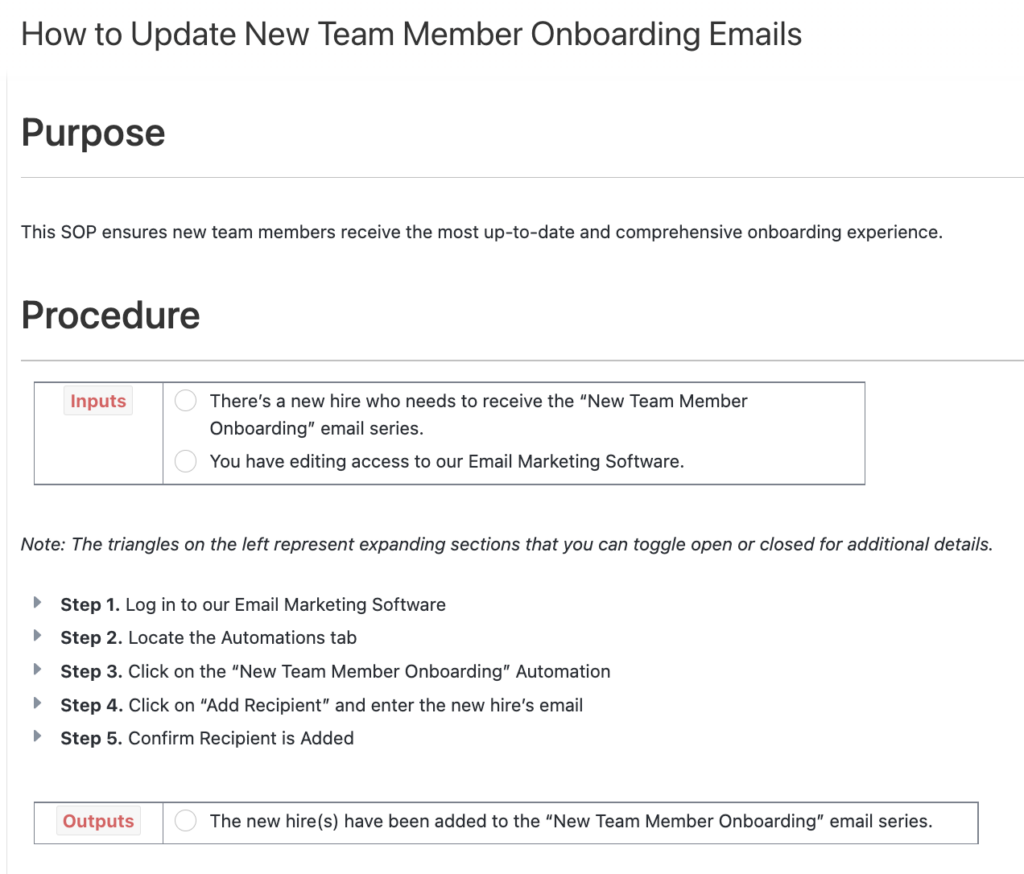
These Steps are our guideposts to navigate from the Start to the Stop of a given Standard Operating Procedure. Each step should be a short phrase – not a long paragraph! – and read like a heading inside a Buzzfeed article.
Step 4. (Optional) Add an FAQ/Resources Area
If you’d like, you could add an extra section after your “outputs” or “stopping point” where you’d dump any frequently asked questions, supporting images or videos, website links, etc.
Anything that you believe will help your team understand a specific SOP should be added to this section.
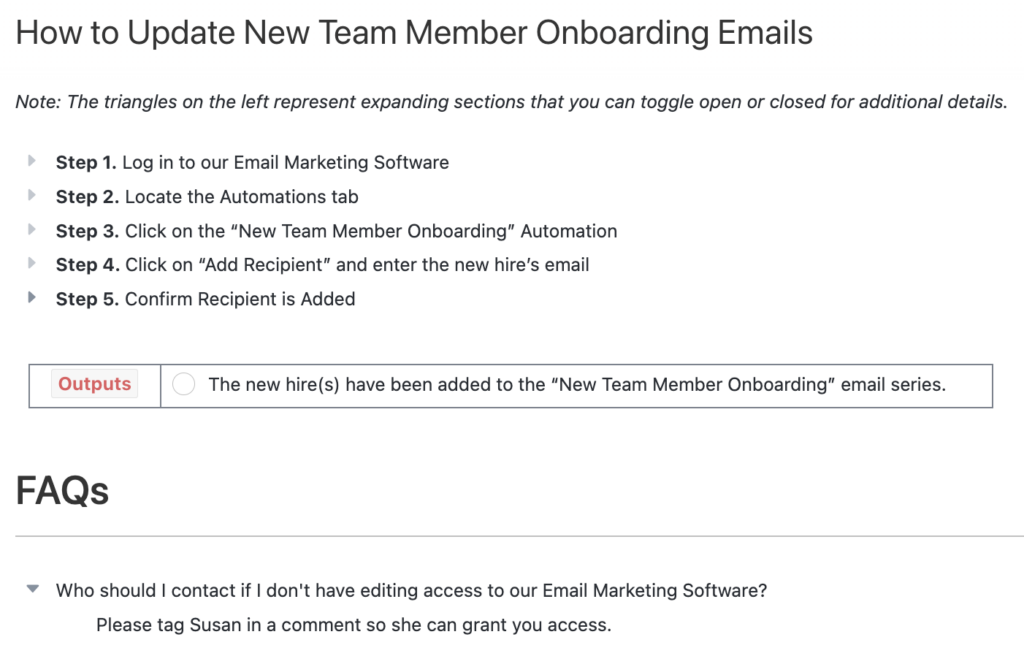
Step 5. (Optional) Write Additional Details to Steps of the SOP
Phew! We’ve got our basic Standard Operating Procedure outline down. Now, we have the choice to add more details to each step of the procedure we defined above.
For many people, it’s helpful to take a few moments to add images, links, or videos to break down how to achieve each step. This is optional but can be an excellent way to add additional clarity.
For example, “Step 4. Click on “Add Recipient” and enter the new hire’s email.” might be expanded to include an image demonstrating where to find the “Add Recipient” button.
While details are helpful, don’t go wild here! This step should not feel like writing a research paper. Focus on only essential information and bite-size support references that help users easily follow the instructions.
And just like that, we have an SOP!
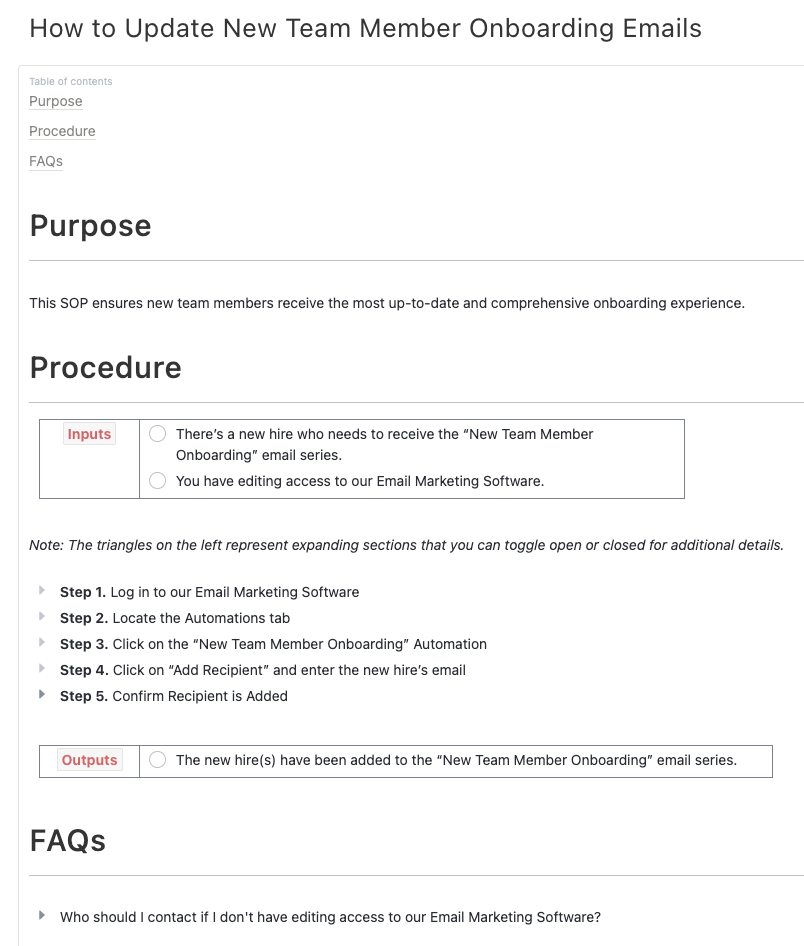
(Remember: Once you have your SOP template outlined and saved in your software, creating a new SOP should happen quickly. It shouldn’t take more than 15 minutes.)
Don’t believe us? Watch this live example where Layla at ProcessDriven takes you through the entire SOP creation process in real-time. I promise it’s not scary!
Who Should Create SOPs?
Okay, so you know the basics of an SOP…but who is the person on your team who should be creating them?
Why Leaders Should Not Write SOPs
First, let’s start with who should NOT create SOPs.
Most people believe that the business owner should be responsible for creating SOPs. It’s their business, so they would be the best person to know how they want things to run, right?
Wrong!
Business owners, CEOs, and upper management should NOT be creating SOPs.
That’s because leadership generally is not familiar with the day-to-day responsibilities and nuances of detailed processes that happen within the organization. Leaders, typically, are focused on leadership!
When leaders write SOPs, big-picture details are overemphasized, and the experience of day-to-day workers is usually under-represented. This will lead to a divide between the ones writing the instructions and those experiencing the work. Over time, this will increase the likelihood of an SOP becoming outdated or blatantly ignored.
Since you know what not to do, let’s move on to our recommendation on creating the perfect SOP!
Why Doers Write the Best SOPs (ProcessDriven’s Recommendation for SOP Creation)
We believe the person who executes a given process is the best equipped to write an excellent SOP about that process.
By having the “doer” document the procedure, we ensure SOPs are focused on the information most useful in the eyes of the doer.
Plus, the sense of ownership of that SOP’s maintenance and use remains as close as possible to the doer, encouraging SOPs to stay updated and be utilized.
Standard Operating Procedure (SOP) Examples for Small Businesses
Now that you understand the power of Standard Operating Procedures, we need to figure out exactly which process in your small team would benefit from written instructions.
I’ll provide a list of example SOPs by business function and business model below to get you started! (For even more examples, you can also unlock our free PDF of SOP examples.)
Every business has different needs. A service-based business has very other processes than an e-commerce business. It’s no surprise that the actual SOPs they would have in their company will look slightly different.
Let’s review some common SOP examples from which every team can benefit!
Marketing Department SOP Examples
If you have a dedicated Marketing department or person responsible for all things Marketing, some common SOPs that this department would benefit from are:
-
- How to Collect Testimonials From Our Public Audience
-
- How to Create an Email Automation
-
- How to Reply to Social Media Messages
Legal Department SOP Examples
It’s safe to assume that every business has a Legal department (or at least a dedicated person that handles legal matters).
Some common SOPs that this department would benefit from are:
-
- How to Cite Our Terms & Conditions
-
- How to Resolve Customer Violating Terms & Conditions
-
- How to Send a Cease and Desist Letter
Do you notice a common theme? Each SOP should start with “How to” and should be succinct.
Of course, we can’t forget about the fulfillment side of business! Depending on your organization’s business modes, you might also need some of the following SOPs:
Product-Based Business SOP Examples
If you’re a product-based business, product development and order management can be an incredibly involved process. To help each SKU reach a customer, we need SOPs! Some common SOPs that a product-based business would benefit from are:
-
- How to Take Inventory
-
- How to Cancel an Order
-
- How to Process a Refund
Service-Based Business SOP Examples
If you’re a service-based business, client communication and the client experience are essential to maintain good relationships with them. To ensure the best possible experience for your clients, we need SOPs! Some common SOPs that a service-based business would benefit from are:
-
- How to Create an Invoice
-
- How to Communicate with Clients
-
- How to Track the Customer Journey
Content Creation-Based Business SOP Examples
If you’re a content creation-based business, planning and ensuring your automations are working are two areas that are crucial to the stability of your business. To ensure the production and publishing process flows smoothly, we need SOPs! Some common SOPs that a content creation-based business would benefit from are:
-
- How to Schedule a YouTube Video
-
- How to Proofread a Blog Post
-
- How to Send a Newsletter
If you’d like to learn about more common SOPs (109 to be exact), check out our free SOP Checklist!
Freebie: SOP Checklist PDF (list of standard operating procedures examples by department)
If you have looked up the phrase “SOP examples” on your search engine of choice, chances are, not a lot of information is populated. This can be pretty discouraging to a manager or leader who knows they need to start creating Standard Operating Procedures.
Every business must implement solid SOPs that teams can easily follow. ProcessDriven is here to help small teams understand the importance of documenting their processes!
That’s why we created 109 time-saving SOPs that we believe every team can benefit from! In this downloadable checklist, we include common SOPs in each of the following departments:
-
- Marketing
-
- Sales
-
- Fulfillment
-
- Operations
-
- Legal
-
- Finance

You can grab your FREE copy of this SOP checklist at https://processdriven.co/sops
Where should you write your SOPs?
Two Options for SOP Creation: Offline & Online
When it comes to storing your SOPs, there are numerous options. (You can even store them on paper if that’s your thing).
Others might prefer the latest software to hit the market, while others might prefer the project or task management tool they’ve used for years.
With so many tools available, choosing the best for your team’s needs can be tricky. When looking for the best software to store your team’s SOPs, you need to look at the following criteria:
3 Criteria for Deciding Where to Store Your SOPs
#1 Ease of Access
Can your team easily access this tool? Is this tool easy to use?
If you spend more than five minutes just searching for where your SOPs are stored, you might be using the wrong tool.
#2 Ease of Editing
How easy is it to edit your SOPs?
If, in order to edit, you and your team need to go through a bunch of steps, that tool might not be worth it. You want to ensure you’re choosing a tool that makes it as easy as possible for your team to go in, make some quick changes, and continue with their work day.
#3 Security & Backups
Does the tool guarantee that your files will never disappear? Is there a clear policy or guideline for handling backups and where to find them? How about security? Is the tool compliant with any local laws that protect your private information?
If the tool you’re considering doesn’t have a clear Security & Backup policy or guideline – run.
Your SOPs are far too important to be accidentally lost or, worse…have some hacker steal sensitive information and sell it online.
Best Types of (Free) Software for SOPs
Now it’s time to determine which software or tool you’d like to store your SOPs! Chances are you already have one of these tools in your tech stack.
When determining which tool you should implement with your team, consider the following criteria:
-
- It needs to be cloud-based (or at least have the option to upload to the cloud).
-
- It needs to be centralized (AKA, ensure everyone on your team has access to this area).
-
- It needs to be easy to use and easy to update.
Here are some common software types to store your SOPs:
| Local Word Processors (Microsoft Word, Dropbox Paper, etc.) | Cloud-Based Documents (Google Docs, Dropbox Paper, etc.) | Process Management Software (Process Street, Trainual, etc.) | Work Management Software (ClickUp, Monday.com, SmartSuite, etc.) | Database Software (Airtable, Notion, Coda, etc.) | |
| Link | https://processdriven.co/dropbox | https://processdriven.co/googledocs | https://processdriven.co/processst | https://processdriven.co/clickup | https://processdriven.co/notion |
| Cost | Free – $30+/month | Free – $18+/month | Free – $30+/month | Free – $29+/month | Free – $10+/month |
| What’s Good | – Various plan options – Low-cost options – A good amount of storage even on the cheapest plan – Your SOPs will be linked to your local account, so accessing your SOPs should be a breeze – You can access your SOPs both online and offline |
– Low-cost options – A good amount of storage even on the cheapest plan – You can access your SOPs both online and offline |
– Specialized and sophisticated features make updating, monitoring, and revising processes and SOPs easy – Tend to see a significant number of integrations with onboarding, training, and automation software |
– Lots of features – Dedicated Support Team – Natively integrates with many apps/tools |
– These tools specialize in storing large amounts of data, so you can feel confident your SOPs will be able to be quickly skimmed – Visualizing and reporting on SOPs can be more sophisticated than other software |
| What’s Bad | – When storage runs out, you’ll have to buy more GB – It can get cluttered if you don’t have a proper file storing process |
– When storage runs out, you’ll have to buy more GB – It can get cluttered if you don’t have a proper file storing process |
– Expensive and generally priced per user, making it challenging to collaborate with casual team members – Can feel out of the way, and the additional friction caused by being in a standalone software can result in SOPs not being utilized |
– Lack of Language options – Quality < Quantity – Small font sizes |
Database software tends to be a bit more flexible, making it hard to control the updating of SOPs. |
| Perfect For | People looking for a cheap (often free) and simple solution | People who prefer a simple SOP storage solution with no frills | People who prefer a more sophisticated software | Tools like ClickUp are fantastic for tech geeks who appreciate the added functionality of a dedicated work management tool to have everything (including SOPs) in one place. They even have a ready-to-install SOP Template! | People who want a dedicated SOP software |
Keep in mind to look at what you currently use in your business before signing up for new software. You might already have something that checks all the boxes for a great option. That way, you don’t have to spend a long time learning new software and teaching it to your team.
Remember, even a piece of paper can work as a place to store your SOPs.
At the end of the day, whichever tool you implement, the important thing is that you feel comfortable using this software.
Ways to Ensure SOPs are Used (and Useful)
There’s no point in investing in SOPs if they aren’t being used. Why waste time and energy creating something that no one will use? I know I wouldn’t.
If your team isn’t using your SOPs, something is wrong.
Some common reasons your team might not use your SOPs are because:
-
- Your team memorized the SOPs
-
- Your SOPs are terrible (sorry!)
-
- Your team doesn’t trust your SOPs
Instead of investing your energy into SOPs that just collect dust, implement these three SOP best practices to ensure SOPs are providing value:
Approach #1: Make it a team effort to keep SOPs updated.
Typically, we see the business owner or manager creating SOPs.
Rather than having one person own a particular SOP, have multiple people involved in the creation and updating process. That way, they are more likely to use them since they played a part in their creation.
Approach #2: Ensure SOPs are conveniently located (easy to edit and access).
Your team might not use your SOPs because they don’t even know they exist.
To prevent this, ensure that wherever you store your SOPs is located in a centralized place that every team member can easily find. If you make it complicated to access SOPs, your team members will get frustrated and give up altogether.
They’ll just do the process the best way they know – relying on their memory – which is the opposite of what we want.
Approach #3 Measure and monitor your SOPs.
It’s essential to constantly check on your SOPs to ensure they are as solid as can be. If your SOPs are collecting dust, they will eventually become outdated.
Remember, things are constantly changing in your business, so your SOPs should reflect that!
It might be worth creating a recurring task in your tool of choice (or even on your calendar) to update them regularly, perhaps once a quarter. This ensures that the SOP is as effective as can be.
Approach #4 Make them part of day-to-day conversation.
We mentioned that having your SOPs in a centralized location is crucial. It’s also crucial to discuss SOPs on a regular basis.
We want to ensure that our team regularly updates the SOPs they own. If our team doesn’t periodically discuss them, they will forget about them. They’ll know the SOPs exist, but they won’t give them much thought.
It’s also important to update fellow team members whenever someone creates a new SOP so you’re all on the same page.
Take an opportunity at the next team meeting or wherever you communicate with your team – whether in person or through a digital communication tool – to update your team on the SOPs that were recently added or updated. It shouldn’t take more than 5 minutes, and it’ll save you (and your team) a lot of headaches down the line.
Still need more SOP training?
After reading this article, if you still feel a bit lost about creating SOPs, that’s okay! The SOP creation journey isn’t easy, so we commend you for making it this far.
This section will highlight additional SOP resources that might help you out.
Fair warning, we can’t guarantee that all of these resources will turn you into an SOP creation god. I want to ensure you solve your SOP puzzles, so don’t hesitate to contact us or watch our free strategy training, The Blueprint, to learn more about organizing your team’s operations.
Here are some additional resources you can use if you still need some more SOP training:
-
- Check out this article to learn more about building SOPs and the three parts of any great SOP.
-
- Check out this article to learn more about building business systems and the three steps to systemize any workflow.
-
- Check out this article to learn more about SOP management and updating SOPs.

Looking for Standard Operating Procedure Examples to get inspired by? Don’t forget to download the 109 SOP examples that every team can consider when turning their operations into a well-oiled machine. Unlock your free PDF download at https://processdriven.co/sops
Tailor SOPs by considering each team’s unique tasks and tools. An HR SOP might focus on policies and employee relations, while IT SOPs detail technical protocols.
Review SOPs at least annually, or more frequently in fast-evolving departments, to ensure they reflect current practices and tools.
To ensure consistent SOP use, provide hands-on training and frequent refreshers, and make updates based on team feedback.
